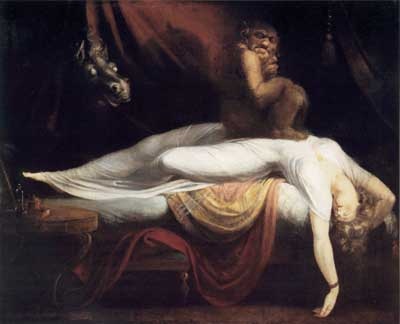 |
Parasomnias and Related Risk FactorsJune 25th, 2011 |
Scope of the Meeting
Last edited | | by Maurice M. Ohayon, MD, DSc, PhD
Additional Information | Introduction to Parasomnias | Bruxism | Confusional Arousals | Sleep Paralysis | Sleep Terrors | Sleep Violence | Sleepwalking | Hypnagogic Hallucinations | Nighmares | Snoring | Publications
Parasomnias are physical events or experiences that interfere with sleep. They are characterized by abnormal behavioral or physiological events that can occur at sleep onset, during different sleep stages, or during arousals from sleep.
These disorders have seldom been investigated in the adult general population although they are estimated to be relatively common phenomena. Little is known about their prevalence and associated risk factors in the general population. Our knowledge about prevalence and incidence of parasomnias is limited compared to dyssomnias. Most of the available data are based on the main symptoms of parasomnias not the diagnoses. Furthermore, not all behaviors that occur during sleep can be classified as a parasomnia event. Additional understanding is needed to help define how best to assess these events, their severity, and potential for impact on patient safety.
Information about associated factors and triggers of a parasomnia episode is also limited as are the data related to the prevalence and relative frequency of events that are benign in nature versus those that could be considered more serious (e.g., sleep driving or sleep walking with a fall risk). Consequences on daytime functioning and emotional distress experienced following a parasomnia episode are undocumented at the epidemiological level. Therefore, it is difficult to ascertain what proportion of these individuals are truly in need of treatment. At the genetic level, there is some evidence that parasomnias may have a genetic component. Therefore, epidemiological genetic links need to be studied. Ethnicity also could play a role in some parasomnias. However, with the exception of sleep paralysis, the role of race has not been investigated. At the pharmacological level, there is some suggestion that psychotropic medications and certain premorbid behaviors related to medication use may have a role in the occurrence of some parasomnia episodes. The importance of this association remains undocumented at the epidemiological level and is in need of further study.
As many factors appear to influence the occurrence of parasomnias, identification of specific risk factors (e.g., family history, medical history, medications, sleep deprivation) is required.
Program
Saturday, June 25, 2011
| 08:15 - 08:30 |
Maurice Ohayon, MD, DSc, PhD Opening remarks |
| 08:30 - 08:50 |
Maurice Ohayon, MD, DSc, PhD Epidemiology of nocturnal awakenings |
| 09:00 - 09:20 |
Seung Chul Hong, MD, PhD Prevalence and Risk Factors of Parasomnias In Asia |
| 09:30 - 09:50 |
Michael Thorpy, MD A video presentation of Parasomnias |
| 10:00 - 10:15 | Break |
| 10:15 - 10:35 |
David Gozal, MD Parasomnias in Children: A Virtually Unexplored Area of Sleep |
| 10:45 - 11:05 |
Michael Vitiello, PhD Parasomnias in Older Adults |
| 11:15 - 12:05 |
Christian Guilleminault, MD NREM Parasomnia and Sleep Instability |
| 12:15 - 13:30 | Lunch |
| 13:30 - 13:50 |
Ronald Chervin, MD, MS Polysomnographic Assessment for REM Sleep Behavior Disorder |
| 14:00 - 14:20 |
Colin Shapiro, MD, PhD Sleep markers and the utility of sleep recordings in Parasomnias |
| 14:30 - 14:50 |
Ruth Benca, MD, PhD Application of high resolution EEG to the study of parasomnias |
| 15:00 - 15:20 |
Kenneth Lichstein, PhD Confusional Arousals |
| 15:30 - 15:50 |
Mark Pressman, PhD Sleep Driving: Sleepwalking Variant, Residual Drug Effect or Both? |
| 16:00 - 16:15 | Break |
| 16:15 - 16:35 |
Mark Mahowald, MD Violent Parasomnias |
| 16:45 - 17:05 |
Thomas Neylan, MD Posttraumatic Parasomnia |
| 17:15 - 17:35 |
Ruth O'Hara, PhD. Restless Leg Syndrome: Elevation to its own Diagnostic Category in DSM-5 |
| 17:45 - 18:05 |
Andrew Krystal, MD Are Hypnotic Medications A Risk Factor for Parasomnias? |
| 18:15 - 18:35 |
Phyllis Zee, MD, PhD Circadian Rhythms: Role in Parasomnias? |
| 18:45 - 19:00 |
Maurice Ohayon, MD, DSc, PhD Conclusions |
Sunday, June 26th, 2011
| 08:45 - 09:00 | Overview of the Symposium |
| 08:15 - 10:00 | General Discussion |
| 10:00 - 10:30 | Closing Statements |
Presentation Abstracts
Click here
This activity is supported by an Educational Grant from Neurocrine Biosciences to Stanford University.
